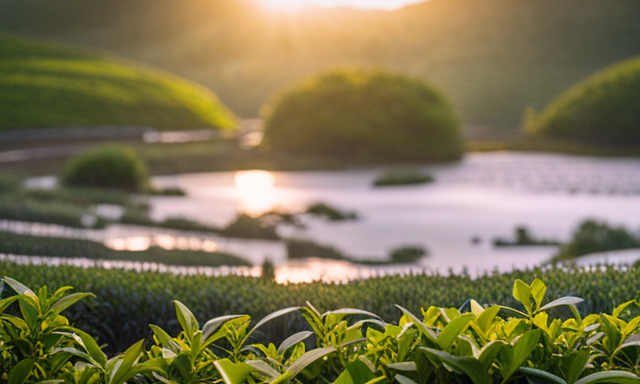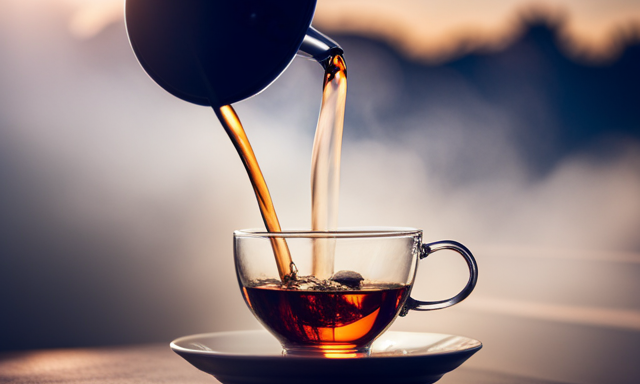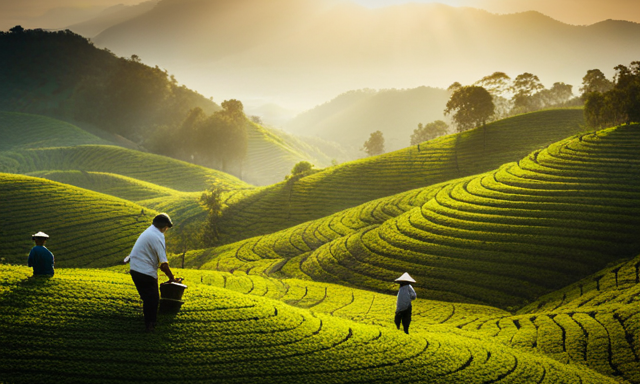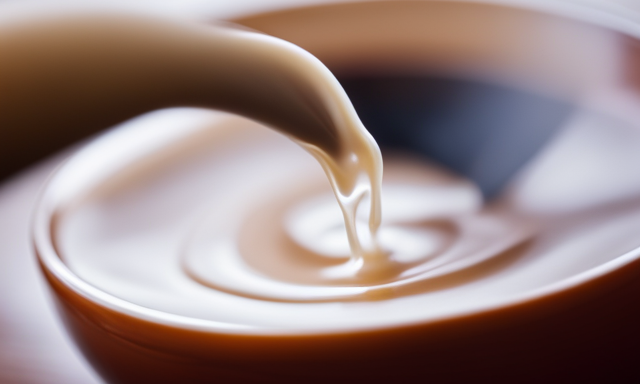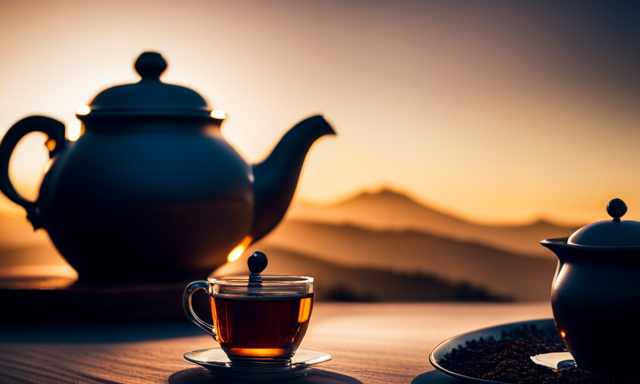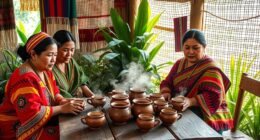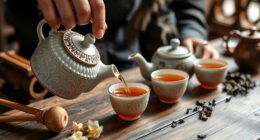Like a warm embrace on a chilly evening, oolong tea has always been my go-to beverage for its unique and comforting flavor. But what if I told you there are other teas out there that can rival its taste?
In this article, we will explore the world of tea and discover the delightful alternatives to oolong. From the bold and robust flavors of black tea to the delicate and grassy notes of green tea, we will take a journey through a range of teas that offer a similar sensory experience.
We will also delve into the earthy and fermented pu-erh tea, the fragrant and floral jasmine tea, and the smooth and mellow tie guan yin tea.
Whether you are a tea connoisseur or simply curious about expanding your tea palate, this article will guide you in finding teas that can satisfy your cravings for that distinctive oolong taste. So sit back, relax, and let’s embark on this tea-tasting adventure together.
Key Takeaways
- Tie Guan Yin, Darjeeling, Pouchong, and herbal tea blends can offer similar flavors and experiences to oolong tea.
- Brewing methods can bring out different flavors in teas, including oolong and its alternatives.
- Green tea provides a refreshing and citrusy contrast to the taste of oolong tea.
- White tea and herbal teas, such as chamomile and lemongrass blends, can provide a bright and citrusy flavor profile similar to oolong.
Black Tea
If you’re looking for a tea that will awaken your senses and leave you feeling bold and invigorated, black tea is the perfect choice for you.
Black tea, like oolong, is known for its rich and robust flavor. However, there are some key differences in flavor profiles between the two.
While oolong tea has a slightly floral and fruity taste, black tea offers a bolder and stronger flavor with notes of malt, caramel, and even chocolate.
Additionally, black tea is known for its health benefits, which include improved heart health, digestion, and potential cancer-fighting properties. It also contains antioxidants that can help boost your immune system.
Moving on to green tea, you’ll find a completely different taste and set of benefits.
Green Tea
When it comes to green tea, there are a few key points to consider.
Firstly, green tea is known for its lower oxidation levels compared to other teas like black tea or oolong tea. This results in a lighter and more refreshing flavor profile that is often described as grassy or vegetal.
Some popular varieties of green tea to try include sencha, matcha, and jasmine tea, each offering a unique taste and experience.
Differences in Oxidation Levels
You just can’t find another tea that comes close to the unique taste of oolong, no matter how much you search. Oolong tea stands out because of the differences in tea processing, specifically the variation in oxidation levels.
This crucial step in oolong production is responsible for its distinct flavor profiles. As the oxidation level increases, the flavor of the tea transforms, resulting in a wide range of taste experiences.
Oolong tea can be lightly oxidized, resembling green tea with its fresh and grassy notes. On the other end of the spectrum, heavily oxidized oolongs exhibit deeper, richer flavors with hints of fruits, nuts, and caramel.
The diversity in oxidation levels allows oolong tea to cater to different preferences, making it a versatile and captivating choice for tea enthusiasts.
Transitioning into the subsequent section about ‘light and refreshing flavor profiles,’ oolong tea offers a myriad of taste sensations that are sure to delight the palate.
Light and Refreshing Flavor Profiles
Immerse yourself in the world of oolong and experience the invigorating, light, and refreshing flavor profiles that will transport your taste buds to a realm of pure bliss. Oolong tea offers a unique taste that is distinct from other teas.
The differences in brewing methods contribute to its light and refreshing flavor. By using specific water temperatures and steeping times, oolong tea achieves a delicate balance between the robustness of black tea and the subtlety of green tea.
To further emphasize the light and refreshing nature of oolong tea, consider the following sub-lists:
- Oolong teas are often described as floral and fruity, with notes of orchids, peaches, and citrus.
- The oxidation level of oolong teas can vary, resulting in a range of flavors from mellow and buttery to crisp and grassy.
- The health benefits of oolong tea include aiding digestion, boosting metabolism, and promoting heart health.
Now that you understand the unique flavors of oolong tea, let’s explore some popular varieties to try.
Popular Varieties to Try
To truly appreciate the diverse flavors of oolong, why not embark on a journey through some of the most popular varieties available?
One such variety is the black currant oolong, which combines the rich, earthy notes of oolong tea with the sweet and tart flavor of black currants. This infusion creates a harmonious blend that is both refreshing and invigorating.
Another popular variety is the honey peach oolong, which features the natural sweetness of honey and the juicy, succulent taste of ripe peaches. The combination of these flavors with the smooth and floral undertones of oolong creates a tea that is delicately balanced and truly delightful.
As we transition to the next section on white tea, we can explore the milder yet equally captivating flavors it has to offer.
White Tea
White tea is like a delicate breeze of floral and honey notes dancing on your taste buds. It is known for its minimal processing, which sets it apart from other teas. The leaves are picked when they are young and still covered in fine white hairs, giving the tea its name. The minimal processing helps retain the natural antioxidants and polyphenols, making it a healthier choice.
Here are four reasons why white tea is worth trying:
-
Subtle and Refreshing: The light flavor of white tea is perfect for those who prefer a gentle taste that doesn’t overpower the palate.
-
Antioxidant Powerhouse: White tea contains a high level of antioxidants, which help protect the body against free radicals and promote overall well-being.
-
Calming and Relaxing: Sip on a cup of white tea to unwind and enjoy a moment of tranquility.
-
Versatile and Versatile: White tea can be enjoyed hot or cold, and it pairs well with a variety of flavors and foods.
As we explore the world of tea, let’s now delve into the rich and earthy flavors of pu-erh tea.
Pu-erh Tea
When it comes to unique tea experiences, Pu-erh tea stands out with its distinctive fermentation process. This tea undergoes microbial fermentation, which gives it a complex and earthy flavor profile.
The result is a mellow and smooth taste that is unlike any other tea. Some popular varieties to try include raw Pu-erh, aged Pu-erh, and ripe Pu-erh, each offering a unique and intriguing tea experience.
Unique Fermentation Process
Oolong tea undergoes a unique fermentation process, resulting in its distinct taste and aroma. This fermentation process is what sets oolong tea apart from other types of tea, such as black or green tea. During fermentation, the tea leaves are partially oxidized, which gives oolong tea its signature flavor profiles. The flavor of oolong tea can range from floral and fruity to toasty and nutty, depending on the specific variety and processing methods used. To evoke an emotional response in the audience, here is a table showcasing the different flavor profiles of oolong tea:
| Flavor Profile | Description |
|---|---|
| Floral | Delicate and aromatic |
| Fruity | Sweet and refreshing |
| Toasty | Rich and caramel-like |
These flavor profiles make oolong tea a truly unique and enjoyable beverage. Moving on to the next section, let’s explore the earthy and mellow flavor profiles of oolong tea.
Earthy and Mellow Flavor Profiles
If you’re looking for a tea that will transport you to a serene and tranquil setting, you’ll love the earthy and mellow flavor profiles of oolong tea. Oolong tea offers a unique taste that is distinct from other teas, making it a perfect choice for those seeking herbal tea alternatives.
Its fermentation process gives it a rich and smooth flavor with hints of roasted nuts and a subtle floral aroma. The earthy undertones create a sense of grounding, while the mellow notes provide a calming sensation.
In addition to its delightful taste, oolong tea also offers numerous health benefits. It is known to boost metabolism, promote digestion, and support weight loss.
With its herbal tea alternatives and health benefits, oolong tea is truly a remarkable beverage to indulge in.
Transitioning to the subsequent section, let’s explore some popular varieties to try.
Popular Varieties to Try
Indulge in the rich and diverse flavors of popular oolong tea varieties, and let your taste buds embark on a tantalizing journey.
Oolong tea comes in various forms, each offering its own unique taste and aroma. One popular variety is Tie Guan Yin, which has a floral and fruity profile with a hint of roasted flavor.
Another well-loved option is Da Hong Pao, known for its deep, rich taste and sweet aftertaste.
Dong Ding oolong tea, on the other hand, boasts a smooth and mellow flavor with a touch of fruitiness.
These teas can be brewed using different methods, such as gongfu style or western style, which can bring out subtle differences in taste and aroma.
Along with its delightful taste, oolong tea also offers numerous health benefits, including improved digestion and increased metabolism.
Transitioning into the next section, let’s explore the enchanting world of jasmine tea.
Jasmine Tea
When it comes to Jasmine tea, I’m always captivated by its aromatic floral notes that fill the air.
The light and fragrant flavor profiles of Jasmine tea offer a delightful experience that is both refreshing and calming.
There are several popular varieties to try, such as Jasmine Dragon Pearls and Jasmine Silver Needle, each offering its own unique nuances and exquisite taste.
Aromatic Floral Notes
Imagine yourself sitting in a serene garden, surrounded by blooming flowers, as you sip on a cup of tea that carries the same aromatic floral notes as oolong. The unique flavor profiles of oolong tea are often characterized by the delicate yet distinct floral undertones that dance on your palate. These aromatic floral notes create a sensory experience that is both enchanting and soothing. To further emphasize the exquisite nature of these flavors, let’s take a look at a comparison between oolong tea and other teas that share similar aromatic qualities:
| Tea Type | Aromatic Floral Notes |
|---|---|
| Oolong | Orchid, lilac, jasmine |
| Jasmine | Strong jasmine scent |
| Rose | Subtle rose fragrance |
As you can see, oolong tea stands out with its complex blend of floral notes, making it a truly remarkable choice for tea enthusiasts. It seamlessly transitions into the subsequent section about light and fragrant flavor profiles.
Light and Fragrant Flavor Profiles
Get ready to embark on a sensory journey as you explore the light and fragrant flavor profiles that will tantalize your taste buds.
When it comes to light and fragrant teas, there are several alternatives to oolong tea that can provide a similar experience. These teas are known for their delicate aromas and gentle flavors, making them perfect for those seeking a more subtle tea experience.
Some popular light and fragrant teas include:
-
Jasmine Green Tea: This tea combines the floral notes of jasmine with the refreshing taste of green tea, resulting in a fragrant and soothing brew.
-
White Peony Tea: With its subtle sweetness and floral undertones, white peony tea offers a light and delicate flavor that is both calming and rejuvenating.
-
Darjeeling Tea: Known as the ‘Champagne of teas,’ Darjeeling tea has a light and fruity taste with hints of muscatel, making it a delightful alternative to oolong.
-
Chamomile Tea: Although not technically a tea, chamomile offers a light and soothing flavor with floral and herbal notes, perfect for relaxation.
Now, let’s dive into the world of popular varieties to try and discover more delightful alternatives to oolong tea.
Popular Varieties to Try
Let’s explore some popular varieties to try and dive into a world of tea options that offer a delightful range of flavors and aromas, like a colorful bouquet of enticing scents that dance on your palate. Oolong tea comes in various forms, each with its own unique characteristics. One popular variety is the Tie Guan Yin, a semi-oxidized tea with a floral aroma and a sweet, lingering aftertaste. Another option is the Da Hong Pao, a heavily roasted tea known for its rich and earthy flavor. For those looking for a lighter option, the Ali Shan oolong offers a delicate and creamy taste. When it comes to brewing techniques, oolong teas are often steeped multiple times to bring out different flavors. Additionally, oolong tea is known for its health benefits, such as aiding in weight loss and promoting heart health. Transitioning into the subsequent section, let’s now explore the world of Darjeeling tea.
Darjeeling Tea
Darjeeling tea, known as the ‘champagne of teas,’ offers a distinct flavor that is often compared to oolong tea. While both teas belong to the same category, they have their own unique taste profiles.
Darjeeling tea has a delicate and floral flavor with a hint of muscatel, which sets it apart from oolong tea. The processing methods also contribute to the differences in taste. Darjeeling tea undergoes a gentle withering, rolling, oxidation, and firing process, which enhances its delicate flavors.
This tea is often referred to as the ‘champagne of teas’ due to its exquisite taste and high quality. With its bright and aromatic notes, Darjeeling tea is a sophisticated choice for tea enthusiasts.
Transitioning to the subsequent section about Tie Guan Yin tea, another oolong tea variety, we delve into the intricacies of its unique flavor profile.
Tie Guan Yin Tea
Explore the unique flavor profile of Tie Guan Yin tea, a variety that you’re sure to enjoy. Its rich and complex taste has gained popularity among tea connoisseurs.
Did you know that Tie Guan Yin tea is one of the top ten most famous teas in China?
What sets Tie Guan Yin apart from other teas is its distinctive processing method. It undergoes a special fermentation process that gives it a floral aroma and a smooth, velvety texture.
This tea also boasts numerous health benefits. It aids digestion and promotes heart health. The antioxidants present in Tie Guan Yin can help boost the immune system and reduce the risk of chronic diseases.
Now, let’s transition to the next section and delve into the wonders of Assam tea.
Assam Tea
As a tea connoisseur, I’m excited to delve into the world of Assam tea. Known for its robust and malty flavor profiles, Assam tea offers a unique taste experience.
Its strong aroma and full-bodied nature make it a perfect choice for those who prefer a bold cup of tea. Additionally, Assam tea shares similarities in body and strength with oolong tea, showcasing its versatility and appeal.
If you’re looking to explore this variety, some popular Assam tea varieties to try include the golden tippy, broken leaf, and orthodox.
Robust and Malty Flavor Profiles
With its rich and full-bodied taste, oolong tea transports you to a cozy autumn afternoon, enveloped in the warm and comforting flavors of malt and robustness. Oolong tea shares some similarities with Assam tea, particularly in their darker and smoky flavor profiles. However, oolong tea stands out with its unique brewing techniques that enhance its distinct character. To truly appreciate its robust and malty flavors, oolong tea requires careful attention to water temperature, steeping time, and multiple infusions. This delicate balance ensures that every sip delivers a harmonious blend of flavors that dance on your palate. Oolong tea’s complexities make it a true connoisseur’s choice, perfect for those seeking a tea that offers depth and sophistication. Moving forward, let’s explore the similarities in body and strength between oolong tea and other varieties.
Similarities in Body and Strength
Oolong tea’s full-bodied and robust flavor profile can transport you to a cozy autumn afternoon, where you can indulge in its rich and malty taste. When it comes to body and strength, oolong tea shares similarities with other teas that have a robust flavor.
However, the brewing methods can vary, leading to differences in taste and aroma. Oolong tea is typically brewed using water that is around 185°F, while other teas may require higher or lower temperatures. This difference in brewing methods can result in variations in the intensity of the flavor and the overall experience.
Additionally, oolong tea is known for its digestive benefits, helping to soothe the stomach and aid in digestion. As we explore popular varieties to try, you will discover how each one offers a unique twist on oolong’s distinct characteristics.
Popular Varieties to Try
Why not explore some of the popular varieties that are sure to captivate your taste buds and leave you craving for more? When it comes to teas that share similarities with oolong, there are a few varieties worth mentioning.
-
Tie Guan Yin: This Chinese tea is known for its floral aroma and smooth, creamy texture. It is often brewed using the gongfu method, which involves multiple short infusions to bring out the complex flavors.
-
Darjeeling: Hailing from the foothills of the Himalayas, Darjeeling tea has a delicate and muscatel flavor. It can be brewed using the traditional method or the western method, depending on your preference.
-
Pouchong: This Taiwanese tea falls between green and oolong, offering a fresh and slightly sweet taste. It is best brewed using lower water temperature to preserve its unique character.
Exploring the different brewing methods and health benefits of these teas will enhance your tea-drinking experience. As we move on to discussing Ceylon tea, another popular variety, you’ll discover even more fascinating aspects of the tea world.
Ceylon Tea
When it comes to Ceylon Tea, one can expect a bright and citrusy flavor profile that is both refreshing and invigorating. The tea is known for its lively and vibrant taste, with hints of orange and lemon that tantalize the palate.
In terms of astringency, Ceylon Tea shares similarities with oolong tea, offering a balanced and slightly dry mouthfeel.
For those looking to explore the world of Ceylon Tea, popular varieties to try include Ceylon Black Tea, Ceylon Green Tea, and Ceylon White Tea, each with its own unique characteristics and nuances.
Bright and Citrusy Flavor Profiles
If you’re craving a tea with a bright and citrusy flavor profile, look no further than oolong’s refreshing counterparts. These teas offer a delightful contrast to oolong’s mellow and earthy flavor profile.
One option is green tea, which is known for its vibrant and zesty taste.
Another alternative is white tea, which has a delicate and subtle citrus undertone.
Lastly, herbal teas such as chamomile or lemongrass can provide a citrusy twist without any caffeine.
The brewing methods for these teas may differ from oolong, but the result is a cup of tea that is bursting with citrus flavors.
Moving on to the next section about similarities in astringency, it’s interesting to explore how different teas can share certain characteristics despite their distinct flavor profiles.
Similarities in Astringency
Indulge in the delightful dance of astringency that lingers on your palate, as you explore the harmonious similarities between oolong and its tea counterparts.
Both oolong and other teas like black and green share a common trait – astringency. This quality, often misunderstood, adds a refreshing and invigorating element to the tea-drinking experience.
Although the level of astringency may vary among different teas, the similarities lie in the way it leaves a slight dryness in the mouth, creating a cleansing sensation. Understanding the differences in brewing methods can enhance the astringency of each tea variety, allowing you to tailor your brew to your preference.
Moreover, astringency in tea has been linked to numerous health benefits, including aiding digestion and promoting antioxidant activity.
Now, let’s move on to the next section and discover the popular varieties to try.
Popular Varieties to Try
Experience the multitude of flavors and aromas by exploring popular varieties of this exquisite tea.
When it comes to teas that taste similar to oolong, black tea and green tea are two popular options worth considering.
Black tea, like oolong, undergoes a full oxidation process, resulting in a rich and robust flavor profile. It can have notes of caramel, malt, and even chocolate, making it a great choice for those who enjoy the complex taste of oolong.
On the other hand, green tea offers a lighter and more vegetal taste, with hints of grassiness and a refreshing finish.
Both black tea and green tea provide unique experiences that can be appreciated by oolong enthusiasts.
Now, let’s move on to the next section and explore the wonderful world of herbal tea blends.
Herbal Tea Blends
Herbal tea blends offer a fascinating array of flavors that can be a great alternative for oolong enthusiasts. These blends combine various herbs, flowers, and spices to create a symphony of tastes that can surprise and delight your palate.
One of the reasons why herbal tea blends can mimic the taste of oolong is their unique fermentation process. Just like oolong tea, herbs used in these blends often undergo a fermentation process that brings out their natural flavors and aromas. This fermentation process adds depth and complexity to the tea, resulting in a rich and satisfying cup.
Some popular herbal tea blends that have a similar taste profile to oolong include chamomile and lavender blend, rose and hibiscus blend, and mint and lemongrass blend. Each of these blends offers a unique combination of flavors that can remind you of the soothing and nuanced taste of oolong tea.
Exploring the world of herbal tea blends can be an exciting journey for those who enjoy the taste of oolong. These blends offer a wide range of flavors and aromas that can rival the complexity of oolong tea, making them a fantastic choice for tea enthusiasts looking for something different.
So why not give them a try and discover a whole new world of tea flavors?
Frequently Asked Questions
How is oolong tea different from black tea?
Oolong tea is distinct from black tea in terms of taste and processing. While black tea is fully oxidized, oolong tea falls between green and black tea with a partial oxidation process. This gives oolong tea a unique flavor profile, different from both black and green tea. While black tea can have a robust and bold flavor, oolong tea is often described as having a more delicate and complex taste.
Can oolong tea be classified as a type of green tea?
Oolong tea cannot be classified as a type of green tea. While they both offer health benefits, oolong tea has a distinct brewing process that affects its flavor. It is a unique tea with its own qualities.
Is white tea similar in taste to oolong tea?
White tea has a delicate, subtle flavor profile that is distinct from oolong tea. While oolong tea is known for its complex and rich taste, white tea offers a lighter and more delicate experience.
What are the main differences between oolong tea and jasmine tea?
When it comes to oolong tea and jasmine tea, the main difference lies in their aroma and taste. Oolong tea has a rich, complex flavor with hints of fruit and a slightly roasted note. Jasmine tea, on the other hand, is infused with the floral fragrance of jasmine blossoms, resulting in a delicate and soothing taste. In terms of health benefits, oolong tea is known for its ability to boost metabolism and aid in weight loss, while jasmine tea is praised for its calming properties and potential antioxidant effects.
Does oolong tea have any similarities with herbal tea blends?
When comparing flavors, oolong tea stands out from herbal tea blends. Oolong has a unique taste, combining floral and fruity notes with a subtle hint of sweetness. Additionally, oolong tea offers numerous health benefits when compared to herbal tea blends.
Conclusion
After exploring various types of teas that taste similar to oolong, it is evident that there are several options to choose from.
Each tea offers a unique flavor profile, ranging from the rich and robust taste of black tea to the delicate and floral notes of jasmine tea.
One interesting statistic to note is that oolong tea is the most consumed tea in Taiwan, accounting for approximately 80% of the tea consumption in the country.
With its distinct taste and popularity, oolong tea is truly a remarkable choice for tea enthusiasts.

